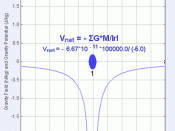Aim
To determine whether the height at which a marble is dropped affect the size of the crater.
Scientific knowledge
Impact craters are geologic structures formed when a large meteorite, asteroid or comet smashes in to a planet or a satellite. Meteorites are small rocks in space that hit the earth's atmosphere at a high velocity. Throughout their history they have heavily bombarded all the inner bodies in our solar system. In this experiment we will use marbles as our meteorites, these will be free falling objects that will be used to copy an asteroid impact. The surfaces of the Moon, Mars and Mercury, where other geologic processes stopped millions of years ago, record this bombardment clearly. On the Earth, however, which has been even more heavily impacted than the Moon, craters are continually erased by erosion and redeposition as well as by volcanic resurfacing and tectonic activity. Thus only about 120 terrestrial impact craters have been recognized; the majority are in North America, Europe and Australia where most exploration has taken place.
The force that makes meteorites fall is gravity. Gravity attracts anything with a mass. The bigger the mass the greater the gravitational pull. The earth's gravitational field attracts meteorites and causes them to collide with the earth's surface.
Here are two examples of craters: -
In this experiment it is more likely that the shape of the crater will resemble the top diagram as the shape of the marble is circle and so it will form a simple crater. Below is another diagram of a common crater in more detail: -
The floor is bowl shaped or flat normally below surrounding ground level unless filled in with lava. The ejecta is a blandet of material surrounding the crater that was dig up during the impact event. The...



Science Experiment
Yours is a well conducted investigation into how the drop height of a marble affects the size of the crater it makes in sand. While most of us would intuitively expect that there would be a direct relationship between drop height and crater size, your report does a very good job in documenting the results of your experiment. Your paper was well organized with helpful headings. I particularly liked the theoretical background you provided before describing the methodology of your science experiment, as well as your overall evaluation. Nicely done!
8 out of 8 people found this comment useful.